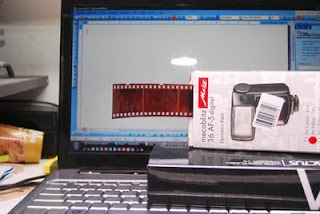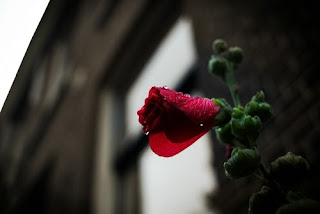WARNING:
Vivitars, and especially this lens, are notorious for problems with the
aperture. This lens is notorious for oil leaking on the blades.
My lens is
one of those lenses with oil leaking on the blades, this causes the blades to
be too slow to close down. Fortunately because of something in the design the
lens doesn’t automatically open up all the way when you put it on your camera
with the aperture closed. It opens up to f/4, giving me two apertures to work
with. (I think this is caused by the higher friction, so the springs which
should open it up all the way are too weak).
Before you
plan to buy this lens, check the serial number. There are multiple versions around, made by
different manufacturers, although I have heard that every version of this lens
is good. My lens is made by Komine.
Handling the lens:
The lens is
pretty heavy, yet it does not feel unbalanced with my d60, and of course this
weight should be expected for a large aperture zoom lens. The lens has a
different design than most lenses: you have to refocus every time you zoom. This
takes some time to get used to, but in the end you’ll keep it in mind.
The design
allows very close focus at the widest end, but only a minimal focus distance of
one meter at 90mm. To be honest I really like this, it gives a nice wide angle
look to your near-macro shots, something you don’t see very often.
Handling the lens without metering:
If you use
this lens on a consumer grade Nikon camera you’ll probably lose metering. but if you get the hang of guessing
the exposure this lens will not pose any problems. Yes this lens has a variable
aperture, but it’s only half a stop, so if you forget to adjust you can easily
fix it in post. And because you have to refocus anyway after you’ve zoomed this
lens in or out you’ll probably remember adjusting the exposure just a bit.
Results:
The lens
shows quite some chromatic aberration wide open, especially wide open. Yet your
post production program is very well able to remove this. When you close it
down, there still is some CA but you have to look for it. However I like to get
rid of it anyway since it takes almost no effort.
Sharpness is
almost OK wide open. You get a usable image, but if you look your photo at 100%
you see that is soft compared to a prime shot wide open. I’m not sure if this
is a fair comparison, a prime has an easier construction, but why would you
settle for less if you also have a prime? However if you close it down one stop
it sharpens up to very usable levels, but don’t expect extreme sharpness.
Bokeh is
ok, nothing really special, but also not very distracting.
There are
some downsides though, this lens is pretty prone to flare. Sometimes the flare
is all over your photograph, reducing the contrast. You can use this to your
advantage, but sometimes it just happens too often and easy.
I have
heard quite some complaints about vignetting, but because I use this lens on a
DX sensor I have not yet noticed it. When I shoot it against a white wall I’ll
probably see it, but until now I have not seen it in “real” photographs.
 |
| (the highlights in the background is flare caused by a flash positioned at 60 degrees from camera left) |
Conclusion:
Buy this
lens if you want an easy lens with a lot of possibilities, and that’s the
reason I like it. You get a useful range, you can focus really close and you
have a fast lens. This sounds too good to be true, and of course it is. The results
are ok, but not amazing. I think that’s the reason I don’t use it very often,
because I also have a 28mm and 50mm which do have amazing image quality and are my preferred focal lengths.











































